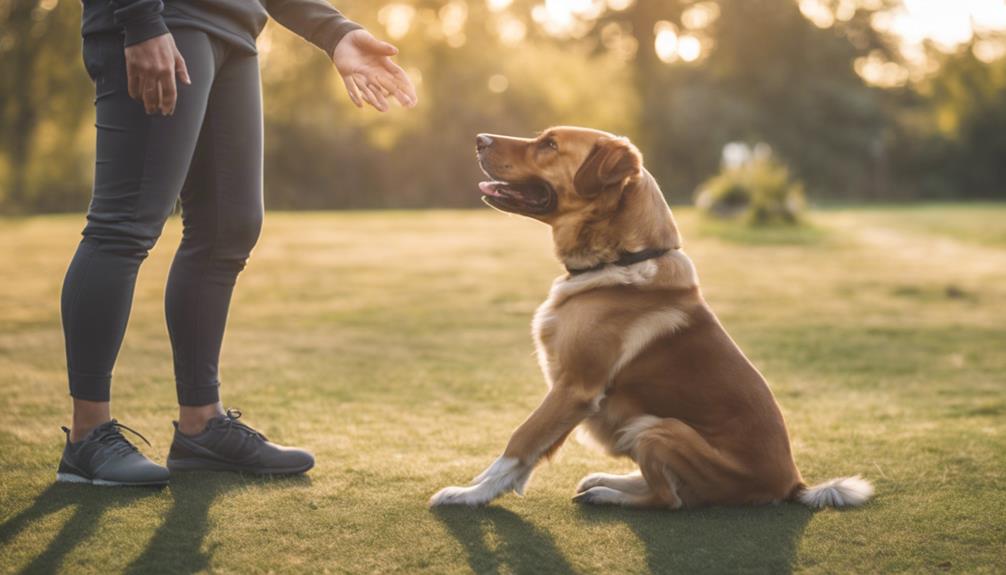6 Best Ways Dog Psychology Influences Training Success
Have you ever wondered how understanding your dog's psychology can enhance the success of their training?
The intricate interplay between canine behavior and training techniques is a fascinating realm to explore. By delving into concepts such as pack dynamics, social hierarchies, instinctual drives, emotions, and communication styles, you can unlock the key to effective training methods.
But there's more to discover beyond the surface level. Understanding how these factors influence your dog's responses can truly revolutionize your training approach.
Canine Behavior and Training Techniques
When training your dog, understanding canine behavior and utilizing effective training techniques are essential for success. Dogs, like humans, have different learning preferences. Some may respond better to visual cues, while others may prefer verbal commands. By observing your dog closely, you can identify their learning style and tailor your training methods accordingly.
Behavior modification is another crucial aspect of training. Whether you're trying to teach your dog a new trick or correct a behavioral issue, positive reinforcement is often the most effective approach. Rewarding good behavior with treats or praise can help reinforce desired actions, encouraging your dog to repeat them in the future. On the other hand, punishing undesirable behavior may lead to fear or confusion, hindering the training process.
Understanding Pack Dynamics in Training
Understanding pack dynamics in training requires recognizing the social hierarchy within a group of dogs and how it influences their behavior and interactions. Dogs naturally form a dominance hierarchy within a pack, where each dog has a rank or status. This dominance hierarchy plays a crucial role in training, as it can affect how dogs respond to commands and their interactions with both humans and other dogs.
In a training setting, it's essential to establish yourself as the leader of the pack. By assuming the role of the alpha, you gain the respect and trust of your dog, making it more likely to follow your commands. Understanding pack mentality allows you to communicate effectively with your dog and address any behavior issues that may arise from challenges to the established hierarchy.
When training multiple dogs, it's important to consider the pack dynamics and avoid situations that could lead to conflicts over dominance. By understanding and respecting the dominance hierarchy, you can create a harmonious training environment that promotes learning and cooperation among all dogs involved.
Impact of Social Hierarchies on Learning
To optimize learning outcomes in dog training, acknowledging and leveraging social hierarchies within a group of dogs is key. Understanding the dominance hierarchy and its influence on learning behavior is crucial for successful training sessions. Here are some key points to consider:
- Establishing Leadership: Clearly define yourself as the leader to establish order and structure within the group.
- Recognizing Dominant Dogs: Identify dominant dogs and use their influence to help guide and motivate other pack members.
- Balancing Interactions: Maintain a healthy balance of interactions to prevent conflicts and ensure a harmonious learning environment.
- Rewarding Respectful Behavior: Reinforce respectful behavior towards higher-ranking dogs to promote a positive learning atmosphere.
- Addressing Aggression: Address any aggression or challenges to authority promptly to maintain a safe and productive training environment.
Instinctual Drives and Training Responses
Acknowledging dogs' instinctual drives is crucial for understanding their responses to training methods and adapting techniques effectively. Dogs have natural instincts that drive their behavior, such as the urge to hunt, guard, or seek companionship. These instincts play a significant role in how they respond to training. For example, a dog with a strong hunting instinct may be more prone to chasing after small animals or objects during training sessions. Understanding these natural inclinations can help you tailor your training approach to suit your dog's specific needs.
Dogs' behavioral responses are closely linked to their instinctual drives. When training your dog, observe how their natural instincts influence their actions. By recognizing these behaviors, you can adjust your training methods to encourage desired responses. For instance, if your dog has a herding instinct, you can use this drive to teach them tasks that involve guiding or rounding up objects. By aligning training techniques with your dog's instinctual tendencies, you can enhance their learning experience and overall training success.
Emotions and Behavior Modification
When training your dog, recognizing the role of emotions is essential for effective behavior modification. Understanding how emotions influence your dog's behavior can help you tailor your training approach for better results.
- Emotional Regulation: Dogs, like humans, can struggle with emotional regulation. Teaching your dog to manage their emotions can lead to more successful training outcomes.
- Positive Reinforcement: Utilizing positive reinforcement techniques can help foster positive emotions in your dog, making training sessions more enjoyable and effective.
- Consistency: Maintaining a consistent training routine can help regulate your dog's emotions and behavior over time.
- Patience: Practicing patience is crucial when working on behavior modification with your dog. Rushing the process can lead to frustration and setbacks.
- Seek Professional Help: If you're struggling with behavior modification, don't hesitate to seek guidance from a professional trainer who can provide expert advice and support.
Communication Styles Affecting Training
Understanding how different communication styles impact training outcomes is crucial for successful dog training. When training your dog, remember that they pay close attention to your body language and vocal cues.
Dogs can pick up on subtle signals, so maintaining positive body language and using clear, consistent vocal cues will help convey your message effectively. Consistency is key in training – using the same commands and gestures will help your dog understand what's expected of them.
Patience is also essential; dogs learn at their own pace, so remain patient and encouraging throughout the training process. By combining positive body language, clear vocal cues, consistency, and patience, you can create a strong line of communication with your dog that enhances training outcomes.
Stress and Anxiety in Training Sessions

To effectively address stress and anxiety in training sessions, it's important to recognize the signs of distress in your dog and adapt your approach accordingly. Dogs, like humans, can experience stress and anxiety during training, which can hinder their learning progress. It's crucial to create a positive and supportive environment to help your furry friend overcome these challenges.
- Behavioral triggers: Identify what situations or actions might trigger stress or anxiety in your dog. This could be loud noises, unfamiliar environments, or specific commands that they struggle to understand.
- Handling frustrations: Stay patient and calm when your dog is feeling stressed. Avoid getting frustrated or raising your voice, as this can escalate their anxiety further.
- Provide breaks: Allow your dog to take short breaks during training sessions to prevent them from becoming overwhelmed.
- Use calming techniques: Incorporate calming techniques such as gentle petting or soothing words to help your dog relax.
- Seek professional help: If your dog consistently displays signs of stress and anxiety, consider consulting a professional trainer or veterinarian for guidance.
Applying Positive Reinforcement Techniques
To enhance your dog's learning experience and foster a strong bond, implementing positive reinforcement techniques is key in shaping desired behaviors. Behavior shaping involves breaking down tasks into smaller steps and rewarding your dog for each successful completion. Rewards can be in the form of treats, verbal praise, or playtime, reinforcing the behavior you want to see more of.
Clicker training is a popular positive reinforcement method that uses a clicker device to signal to your dog when they've performed the desired behavior correctly. The click sound is paired with treats, creating a clear association between the action and the reward. This method helps your dog understand exactly what they did right, making it easier for them to repeat the behavior in the future.
Frequently Asked Questions
How Does a Dog's Past Experiences Affect Their Behavior and Training Success?
When it comes to your dog's behavior and training success, past experiences play a crucial role. Traumatic events can impact their behavior, requiring specialized behavior modification techniques.
By understanding your dog's history, you can tailor training methods using positive reinforcement. This approach not only helps in trauma recovery but also enhances training success.
Can a Dog's Breed or Genetics Play a Role in Their Learning and Training Abilities?
When it comes to your dog's breed or genetics, it can definitely play a role in their learning and training abilities. Nature vs. nurture, genetics vs. environment – these factors all impact how your furry friend behaves and responds to training.
Some breeds may have innate abilities that make certain tasks easier to learn, while others may require more patience and effort to overcome learned behaviors. Understanding your dog's genetic makeup can help tailor training methods for success.
What Role Does a Dog Owner's Behavior and Interactions With Their Pet Play in Training Success?
When training your furry friend, your actions and consistency matter. By modifying your behavior, using positive reinforcement, and paying attention to communication cues, you can make a huge difference in training success.
Your dog picks up on your cues and reactions, so staying consistent and positive can lead to better results. Make sure to reinforce good behavior and communicate effectively to build a strong training bond with your pet.
Are There Certain Environmental Factors That Can Impact a Dog's Ability to Learn and Respond to Training?
When it comes to training your dog, the training environment and distractions can have a big impact on their ability to learn. A calm and focused environment can help your dog stay attentive and engaged during training sessions.
Additionally, a well-socialized and positively raised dog may be more receptive to learning new commands and behaviors. By setting up the right environment and providing a supportive upbringing, you can enhance your dog's training success.
How Can a Dog's Age or Health Condition Affect Their Training Progress and Success?
As a dog owner, you should consider your pup's age and health when planning training. Senior dogs might've slower progress due to physical limitations, so gentle training techniques are key.
On the other hand, health issues can affect puppy training, requiring patience and understanding. Tailoring your approach to fit your dog's specific needs will lead to more successful training sessions.
Conclusion
Overall, understanding your dog's psychology is crucial for successful training. By recognizing their pack dynamics, social hierarchies, instincts, emotions, and communication styles, you can tailor your training techniques to suit their individual needs.
Applying positive reinforcement techniques will help build a strong bond with your furry friend and ensure a happy, well-behaved companion.
Remember, patience, consistency, and a deep understanding of your dog's psychology will lead to training success.
